

 |
 |
|
 |

|
| About Us |
|
Read Past Issues | Resources | Composer Links |
|
MUSIC NEWS
|
Tania Leon
Over all, Ms. Leon¹s works exhibit angular lines of atonal counterpoint, intersecting, joining and running headlong into each other. The works as a whole also use percussive articulations and gestures from the pitched instruments and dynamic strikes and sounds from the marimba and the non-pitched percussion instruments. This general point is both the music's strength and its limitation. While I am talking about generalizations, the concert as a whole was to me divided into two distinct sections separated by intermission. Although the two halves did not differ that much musically, except for a stirring piece at the end of the concert which featured cello, played very nicely by Edward Arron, set against soprano voice, sung vibrantly by Susan Narucki, they differed in the life and effect of the work and by the way the instrumentalists played. The concert began with Sin Normas Ajenas, a work for ensemble; string quartet, percussion (two marimbas, and non-pitched percussion), oboe, bassoon and flute. It was interesting in the counterpoint it presented and also for the idea that I started to test and that turned out to be one that stuck with me throughout the concert. The angular lines of counterpoint, abrupt discordant gestures and cross rhythms presented a challenging landscape on which to navigate. I started thinking of an analogy of montage and mosaic. This analogy came more into focus in the second piece, A La Par, scored for piano and cello where in an ostinato syncopated latinesque rhythm or rhythms were percussivly interrupted, sliced and spliced together again. The outer movements were frenetic and had a fragmented urban flare to them while the middle movement was relaxed and subtle. The first half ended the with, a montage of angular melodic bursts, bits of sound, things out of the blue coming together to form a whole, which is the idea of montage; the idea of mosaic and collage. On their own they are only random bits of color and sound. They are taken out of context and placed into another context to form the unity of a whole. One hears the bits but also hears the whole. In the first half of the concert I was looking for the whole to present itself and it proved illusive. In the second half it did come together. One important part of Leon's music is that the players cannot be tentative about it. Part of the listening experience is the conviction that went into playing it. This is true of all music but in my opinion even more so in music which the source material is so elemental and seemingly very random at times. The music in the second half of the program had much more of a presence and effect. The compositions themselves were more cohesive which lent them to be interpreted with more conviction. The music was more together as a whole. Interestingly, the first piece of the second half was Azulejos, which means mosaics. A piece for percussion, cello and flute, the three Azulejos face each other, accompanied by piano. This worked well for the ensemble as they were playing it with more verve. And the pieces of the piece came together to form that illusive whole I had been listening for. The second piece was kind of a deconstruction of musical events, breaking them down into elemental pieces. It was like taking a lick and taking it out of time and then extracting the musical elements and extrapolation them under a magnifying glass. This is what happened in my experience but as in abstract art different people see or hear different things sometimes and the art or music is as much about the listener as it is about the composition. The night ended
with a mother's prayer, from Ms. León's opera Scourge of Hyacinths,
the vocal piece noted above. Interesting way to end the evening; plaintively,
melodically and somber.
Old Stuff An Interview with Tobias Picker Handmaid Tale's Debuts in English Rautavaara Joins B&G Who's Afraid of Julia Wolfe Derek Bermel's Soul Garden The Pianist: The Extraordinary True Story of Wladyslaw Szpilman John Adams' Atomic Opera A Bridge Not Far Enough Turnage Signs With B&H Sophie's Wrong Choice Copland's Mexico On Being Arvo Rzewski Plays Rzewski Praising Lee Hyla David Lang's Passing Measures
|
|||||||||||||||||||||
Different Trains Composer: Steve Reich David Robertson, Orchestre National de Lyon Naive This
is a new version of Reich's haunting 1988 masterpiece (the
original used four string quartets--both pre-recorded and live) prepared
for 48 strings by the composer at the suggestion of the conductor
David Robertson. The result further enhances the lyricism and emotional
impact of this powerful piece, which contrasts the trains that young Reich
rode across the United States to visit his divorced parents in the 1940s
with the trains of Nazi Germany during the same period.
It is coupled with two other major scores by Reich: Triple
Quartet (1999) for 36 strings, and The Four Sections (1986), a "concerto
for orchestra" that highlights each of the sections of the large symphony
orchestra in turn
|
Symphonies 2 & 3 Composer: Philip Glass Marin Alsop, Bournemouth Symphony Orchestra Naxos Marin
Alsop conducts the Bournemouth symphony orchestra in extraordinary performances
of Glass' Second and Third symphonies. The Second was comissioned
by the Brooklyn Acadamy of Music and premiered there in 1994 by Dennis
Russell Davies. The Third, which arrived only three years later,
is composed for chamber orchestra. Lots of polyharmonies,
rousing finales, and fully-formed symphonic statements. Essential listening
for anyone interested in contemporary music.
|
Nuit des Hommes Composer: Per Nørgård Markus Falkbring, viola Helene Gjerris, mezzo-soprano Andreas Hagman, violin Kaare Hansen, conductor Fredrik Lindström, cello Helge Rønning, tenor Bodil Rørbech, violin Gert Sørensen, percussion DaCapo First performed in 1996, Nørgård called this "… an opera of sorts …" Whatever it is, it is both radical and powerful. Two singers, male and female, take on three roles each, as well as chorus, over the course of 65 minutes, augmented by two violins, viola, cello and percussion doubling electronic keyboards. The text comes from Guillaume Apollinaire's surreal and emotionally-charged poetry inspired by the atrocities of World War, which also inspired Shostakovich in his Fourteenth Symphony. Raw and riveting. |
The Chamber Music of Aaron Copland Performers: Music From Copland House Michael Boriskin, Paul Lustig Dunkel, ensemble co-directors, Derek Bermel, clarinet, Michael Boriskin, piano, Paul Lustig Dunkel, flute, Nicholas Kitchen, violin, Wilhelmina Smith, cello Arabesque Music From Copland House is the resident ensemble at Aaron Copland's longtime New York home, now restored as a unique creative center for American music. Since its triumphant New York debut at the Opening Night of Merkin Concert Hall's 1999-2000 season, Music from Copland House has emerged as one of the most exhilarating and distinctive ensembles on the American music scene. In this beautifully played two CD set, they return to their roots--the extraordinarily rich chamber pieces of Aaron Copland, who would have been 104 on November 14. This disk is a real sleeper. |
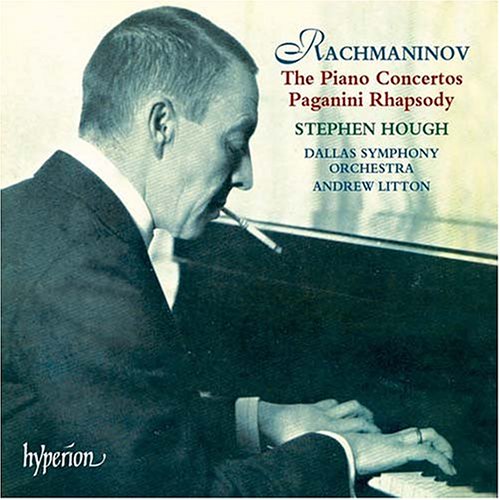
The Piano Concertos, Paganini Rhapsody Composer: Sergei Rachmaninov Stephen Hough (piano), Dallas Symphony Orchestra, Andrew Litton Hyperion You
may find better individual performances of each of Rachmaninov's four
piano concertos (Leif Ove Ondnes's No, 3, for example) but this 2-disk
set is hard to beat as a one-stop listening experience. Cobbled together
from 11 live performances over an 18-day period, the power chord, big sound,
sweeping Rachmaninov romanticism has never sounded, well, bigger or more
romantic. Littton is a Rocky Romantic Show specialist and it
shows in the orchestra's splendid melding with Hough's oversized playing.
Highly recommended, even if you already have them all.
|
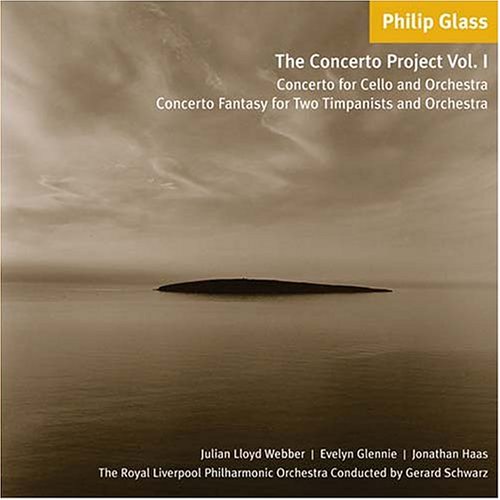
The Concerto Project 1 Composer: Philip Glass Cello Concerto, Concerto Fantasy for Two Timpanists and Orchestra Julian Lloyd Webber (cello), Evelyn Glennie (timpani), Jonathan Haas (timpani), Royal Liverpool Philharmonic Orchestra, Gerard Schwarz Orange Mountain Every
shard of Glass seems to finding its way onto a CD nowadays and it's getting
harder to tell the major Glass from the--forgive me--half Glass.
This is major Glass. The Cello Concerto is a real beauty, played
with real passion by Lloyd Webber and the RLP. The timpani concerto
is great, too, once you get past the thought that maybe Phil borrowed the
opening from Lalo Schifrin. This is the first of a series of four
CDs that Philip Glass and Orange
|
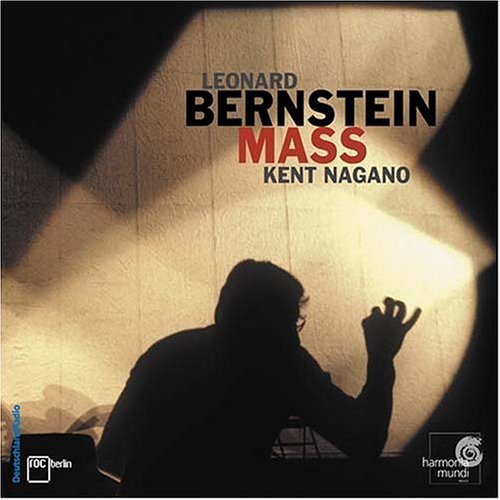
Mass - A Theatre Piece for Singers, Players & Dancers Composer: Leonard Bernstein Jerry Hadley (tenor), Rundfunkchor Berlin, Paci. c Mozart Ensemble, Staats-und Domchor Berlin, Deutsches Symphonie- Orchester Berlin, Kent Nagano harmonia mundi What's
a nice Jewish boy like Leonard Bernstein doing writing a Mass? In
this case, he was invited to do so by Jacqueline Kennedy for the opening
of Kennedy Center in 1971. This is Lennie at his most flamboyant,
employing a big theatrical cast, mixed chorus, children’s choir, dancers
and a rock band. The libretto for Mass intersperses texts written
by Bernstein and Stephen Schwartz (lyricist for Godspell) into the Roman
Mass. The work explores the mass from the point of view of the Celebrant
(sung by Jerry Hadley), who is experiencing a crisis of faith. The Celebrant’s
faith is simple and pure at first, yet that faith gradually becomes unsustainable
under the weight of human misery, corruption, and the trappings of human
power. In the end, the Celebrant, on the verge of renouncing
|
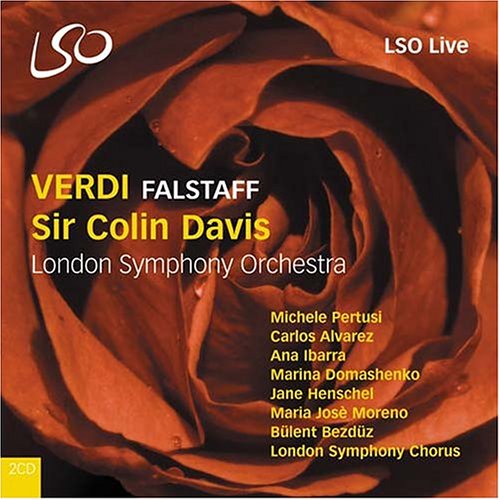
Falstaff Composer: Guiseppe Verdi Michele Pertusi (bass), Carlos Alvarez (tenor), Ana Ibarra (soprano), Marina Domashenko (mezzo-soprano), Jane Henschel (mezzo-soprano), Maria Josè Moreno (mezzo-soprano), Bülent Bezdüz (tenor), London Symphony Orchestra & Chorus, Sir Colin Davis LSO Live Hot
on the heels of their highly acclaimed recording of Britten’s Peter
Grimes, Sir Colin Davis and the London Symphony Orchestra are joined by
a magnificent cast led by Michele Pertusi for a spectacular performance
of Verdi’s comic masterpiece, Falstaff.
|
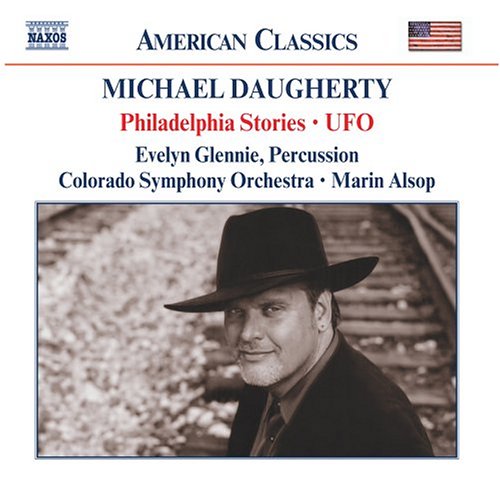
Philadelphia Stories / UFO Composer: Michael Daugherty Performers: Evelyn Glennie, percussion / Colorado Symphony Orchestra / Marin Alsop, conductor Naxos Something
of a coup for Naxos’ American Classics series matching world famous percussionist
Evelyn Glennie with Gramophone Artist of the Year Marin Alsop and the Colorado
Symphony Orchestra with one of America's most intriquing composers.
Daugherty has the uncanny ability to be all things to all listeners without
seeming to comprise either seriousness or an enjoyable listening experience.
|
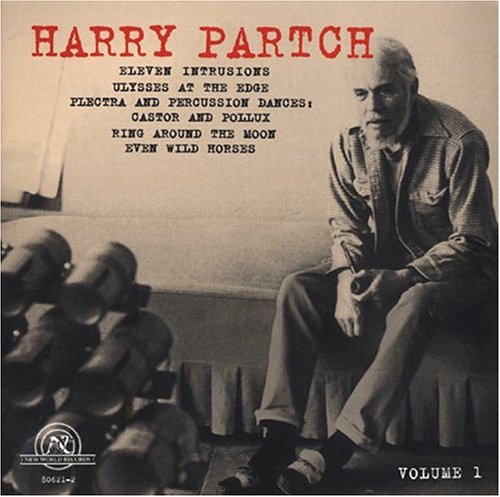
Orchestral Works Composer: Harry Partch Performer: Johnston, Pippin, et al. New World Records These works span the first six years of what American maverick composer Harry Partch (1901–1974) called the "third period" of his creative life. They show him moving away from the obsession with "the intrinsic music of spoken words" that had characterized his earlier output (the vocal works of 1930–33 and 1941–45) and towards an instrumental idiom, predominantly percussive in nature. The Eleven Intrusions are among the most compelling and beautiful of Partch’s works. The individual pieces were composed at various times between August 1949 and December 1950, and only later gathered together as a cycle. Nonetheless they form a unified whole, with a nucleus of eight songs framed by two instrumental preludes and an essentially instrumental postlude. |
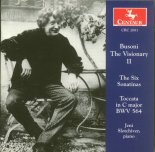
Busoni the Visionary, Volume II Jeni Slotchiver, piano Centaur No one plays Busoni's piano music with greater clarity or depth of understanding than Jeni Slotchiver. As she demonstrated in Volume I of this series, this is music she clearly loves and understands both intellectually and intuitively. There is no finer, or more committed, advocate for this greatly underrated composer working today. See Slotchiver's notes on Busoni the Visionary here. |
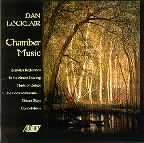
Chamber Works Composer: Dan Locklair Albany Records Dan
Locklair is an organist by trade and although he has written a wide body
of works--his prolific output includes symphonic works, a ballet, an opera
and numerous solo, chamber, vocal and choral compositions--one may be forgiven
for identifying him first with that glorious instrument. These chamber
works show that Locklair's command of musical language is far broader
and deeper than a single instrument. These fresh and engaging
works are musically challenging and yet a real treat for the ear.
|
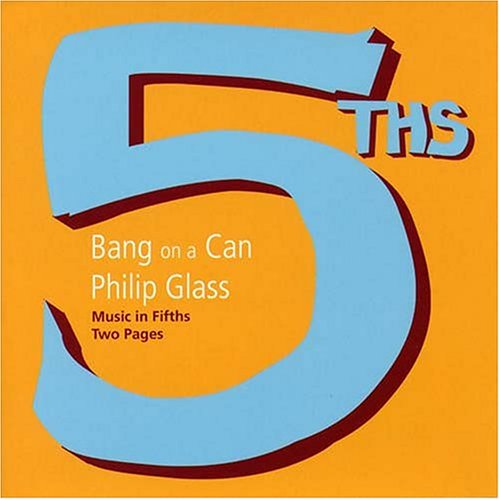
Music in Fifths/Two Pages Composer: Phillip Glass Performer: Bang on a Can Cantaloupe These are transcriptions of two early Glass works ("Fifths," originally performed and recorded by Philip Glass with Jon Gibson and Dickie Landry in the original version for saxophones and electric organ) and ("Two Pages", originally done by Philip Glass on electric organ and Michael Riesman on piano). As always the Bang on a Can All Stars do a... well... bang up job and bring a fresh perspective to two of the seminal works of Glass' early career.
|
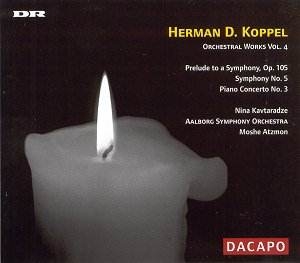
Orchestral Works Composer: Herman D. Koppel Nina Kavtaradze (piano) Aalborg Symphony Orchestra/Moshe Atzmon DACAPO This is the third volume of the symphonies of the Danish composer Herman D Koppel who lived from 1908 to 1998 and wrote seven symphonies between 1930 and 1961. Born in Copenhagen the son of Polish Jewish immigrants, Koppel fled to Sweden during World War II and his Symphony No. 3, written there, is an intensely personal work that mirrors the fears and anxieties of that period. No. 5 is more hopeful and steady but lacks the raw energy of the 3rd. |
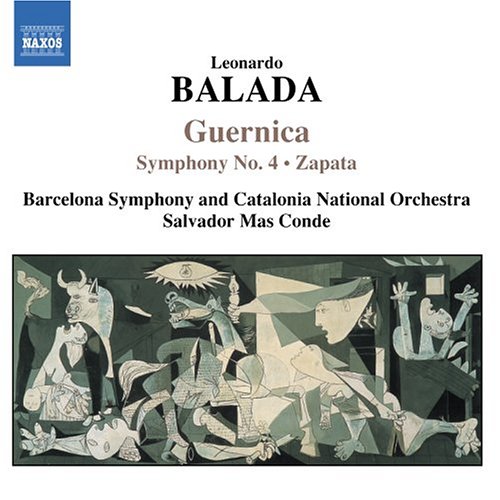
Guernica, Symphony no 4, Zapata Composer: Leonardo Balada Barcelona Symphony and Catalonia National Orchestra/Salvador Mas Conde Balada’s Guernica, completed in 1966, during the height of the Viet Nam War, was inspired by Picasso’s large-scale mural of 1937, which has come to represent a protest piece against all wars. Balada writes in a personal modern idiom, although there are traces of his apprenticeships with Dello Joio and Aaron Copland. Neither a serialist nor neo-classisist Balada is modern in ways that are highly individual and sometimes hard to follow. But, he's an original and a little patience from the listener is well worth the effort. |

Symphonies Nos: 4, 5, 6 Composer: Josef Tal NDR RadioPhilharmonie/Israel Yinon CPO German-born
Israeli composer Josef Tal, whose work I had never heard from this CD,
is said to have derived his musical style from the second Viennese
school and has remained an unrepentant modernist. He has also been an innovator
and pioneer, one of the first to combine a live instrument with a studio-generated
tape recording; he founded the Israel Center for Electronic Music and imported
the first Moog Synthesizer into his adopted country. These three symphonies
reveal a composer with a strong personal voice working at the height of
his powers. Very powerful.
|
 |
Search WWWSearch www.sequenza21.com |
